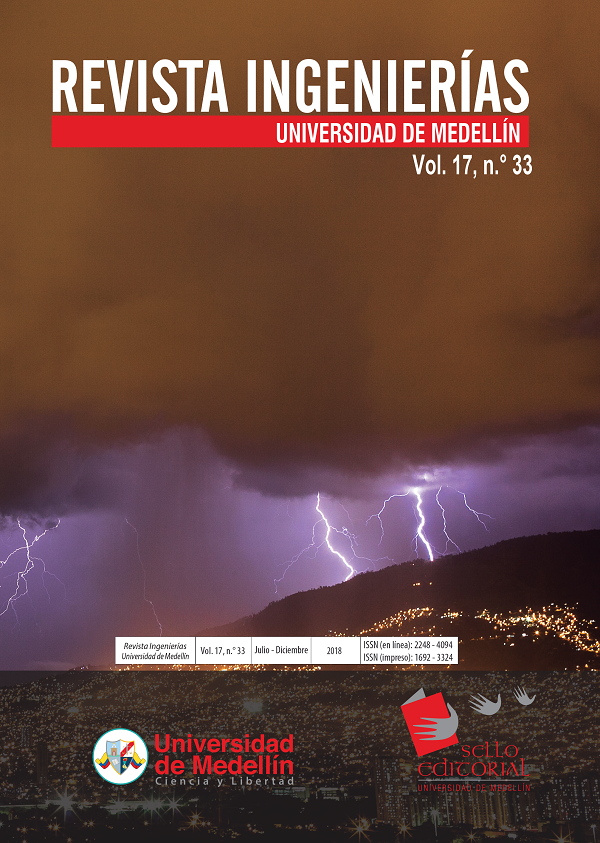Copyright (c) 2023 Revista Ingenierías Universidad de Medellín

This work is licensed under a Creative Commons Attribution-NonCommercial-NoDerivatives 4.0 International License.
- Articles
- Submitted: June 29, 2016
-
Published: March 4, 2018
Abstract
Research carried out on post-installed structural anchors has shown a link between the embedded length and the diameter of the bore with maximum tensile strength. This paper, is the outcome of research funded by the research department of the Universidad Pedagógica y Tecnológica de Colombia, analyzes this link from the variation of resistance and failure type in structural anchor prototypes with variations in embedded length and drilling diameter, in particular compressive strength 28 MPa, epoxy adhesive, reinforcing bar, 15 graphite units of 0.007 m diameter, and 15 corrugated steel units of 0.0095 m diameter, for a total of 30 systems requested for direct traction in the universal machine. The results showed that tensile strength and failure type are a function of the embedded length and corrugated structure of the anchored reinforcing bar.
References
[1] República de Colombia. Ministerio de Ambiente, Vivienda y Desarrollo Territorial, Reglamento Colombiano de Construcción Sismo Resistente Nsr-10, Asociación Colombiana de Ingeniería Sísmica, 2010.
[2] J. Rendón, “Los anclajes adhesivos en la construcción”, Noticreto, vol. 126, pp. 43-47, 2014.
[3] Committee ACI 503, Use of epoxy compounds with concrete, ACI 503 R-93, American Concrete Institute, 1998.
[4] M. Gesoğlu et al., “Modeling and analysis of the shear capacity of adhesive anchors postinstalled into uncracked concrete,” Composites: Part B: Engineering, vol. 60, pp. 716-724, 2014.
[5] M. Obataa et al., “The failure mechanism and the pull-out strength of a bond-type anchor near a free edge,” Mechanics of Materiales, vol. 28, pp. 113-122, 1998.
[6] P. Upadhyaya, y S. Kumar, “Pull-out capacity of adhesive anchors: An analytical solution,” International Journal of Adhesion and Adhesives, vol. 60, pp.54-62, 2015.
[7] Ϛ. Ózlem et al., “Shear strength of epoxy anchors embedded into low strength concrete,” Construction and Building Materials, vol. 38, pp. 723-730, 2012.
[8] S. Yang et al., “Theoretical analysis on pullout of anchor from anchor–mortar–concrete anchorage system,” Engineering Fracture Mechanics, vol. 75, pp. 961-985, 2008.
[9] A. Çolak, “Parametric study of factors affecting the pull-out strength of steel rods bonded into precast concrete panels,” International Journal of Adhesion and Adhesives, vol. 21, pp. 487-493, 2001.
[10] Y. M. Ruda Arias y D.F. Páez Moreno “Anclajes posinstalados en concreto de alta resistencia,” Ciencia e Ingeniería Neogranadina, vol. 27, N.° 2, pp. 137-156, 2017.
[11] M. McVay, et al., “Pullout simulation of post installed chemically bonded anchors,” Journal Structural Engineering, Vol.122, pp. 1016-1024, 1996.
[12] L. Contrafatto, y R. Cosenza, “Behavior of post-installed adhesive anchors in natural stone,” Construction and Building Materiales, vol. 68, pp. 355-369, 2014.
[13] F. Puigvert et al., “Static analysis of adhesively bonded anchorages for CFRP tendons,” Construction and Building Material, vol. 61, pp. 206-215, 2014.
[14] B. Gerber and M. Ekenel, “Building Code Requirements for Inspection of Adhesive Anchors in Concrete”, Journal of Construction Enigneering and Management, vol. 139, 2013.
[15] Post-Installed Reinforcing Bar Guide, Hilti Group, 2016.
[16] Committee ACI 318-11, Building Code Requirements for Structural Concrete and Commentary, American Concrete Institute, 2011.
[17] Sika Colombia S.A., “Hoja técnica Sikadur AnchorFix-4,” [En línea], acceso 14 de abril, 2015; Disponible: http://col.sika.com/es/rehabilitacion-y-reforzamiento/rehabilitarreforzar/02a005/02a005sa01.html
[18] M. Lascarro, “Indicadores en concreto,” [En línea], acceso 14 de abril, 2015; Disponible: https://www.construccionlatinoamericana.com/indicadores-en-concreto/128416.article
[19] Icontec, Concretos. Ensayo resistencia a la compresión de especímenes cilíndricos de concreto, NTC 673, Instituto Colombiano de Normas Técnicas y Certificación Icontec, 2012.
[20] Icontec, Siderurgia. Ensayo de tracción para materiales metálicos. Método de ensayo a temperatura ambiente, NTC 2, I nstituto Colombiano de Normas Técnicas y Certificación Icontec, 1995.
[21] ASTM International, ASTM E488/488M–10 Standard Test Methods for Strength of Anchors in Concrete Elements, ASTM INTERNATIONAL, 2014.
[22] Committee ACI 355, Report on Anchorage to Concrete, ACI 355 1R-91 (Reapproved 1997), American Concrete Institute, 1997.



















